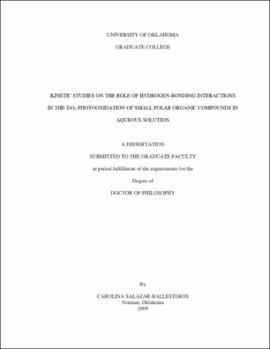| dc.contributor.advisor | Nanny, Mark A.||Richter-Addo, George | |
| dc.creator | Salazar-Ballesteros, Carolina | |
| dc.date.accessioned | 2019-04-27T21:32:38Z | |
| dc.date.available | 2019-04-27T21:32:38Z | |
| dc.date.issued | 2009 | |
| dc.identifier | 99287081002042 | |
| dc.identifier.uri | https://hdl.handle.net/11244/318969 | |
| dc.description.abstract | Drinking and hygiene water sustainability is a current concern due to the rapid pace of global urbanization and the vast coverage gap between urban and rural areas worldwide. Therefore, water recycling has become a necessity to alleviate the fragile state of most of the planet's water resources and has prompted the search for viable and efficient alternatives for wastewater treatment. In response to this search, Advanced Oxidation Processes (AOP), like UV/TiO2 heterogeneous photocatalysis, have arisen and are being extensively investigated. | |
| dc.description.abstract | The general goal of this research was to study, characterize, and model the TiO2-mediated photocatalytic degradation (PCD) of small polar organic compounds (SPOC) as a function of typical water parameters (pH, carbonate-bicarbonate alkalinity, and ionic strength) in order to determine possible base-case conditions that may translate into an efficient photocatalytic method for a final water polishing step. Similarly, we aimed to find experimental evidence that may indicate the important role that hydrogen-bonding interactions may play in the photooxidation of SPOC at the catalyst surface. | |
| dc.description.abstract | Our results showed that the fastest initial degradation rates of model SPOC (isopropanol and acetone) occurred in a pH range 6.04 - 8.61 were the optimal conditions for adsorption through hydrogen-bonding to the TiO2 surface and optimum concentration of hydroxyl radicals coincided. | |
| dc.description.abstract | The kinetic data that resulted from the effect of carbonate-bicarbonate alkalinity in the application of TiO2 heterogeneous photocatalysis for the oxidation of acetone and isopropanol showed that the extent of inhibition on their initial rates of degradation varied according to the type of anions and radicals (CO3-*/ HCO3*) present in the photocatalytic systems. Although it is known that the carbonate anion adsorbs to a less extent on the TiO2 surface than bicarbonate anion, the higher ability for scavenging of hydroxyl radicals of the former had a more detrimental effect on the photodegradation rates of our target compounds at the pH of 10.35. The inhibitory effect of carbonate anions on the photodegradation of isopropanol and acetone was suppressed at the highly basic pH of 12.0. | |
| dc.description.abstract | Under the joint effect of pH and ionic strength, the PCD rates of isopropanol and acetone were susceptible to changes in the Brönsted acid/base character of the TiO2 surface site speciation and depicted the greater enhancement with the increase in ionic strength at pH 6.04 (for isopropanol) and 8.61 (for acetone). Further support to the role of hydrogen-bonding interactions on the PCD of our model SPOC was obtained from the study of 1:1 binary mixtures, since isopropanol, the substrate bearing the best hydrogen-bonding capacities, degraded predominantly in our systems. | |
| dc.description.abstract | Although the construction of a ranking of degradation at the TiO2 surface on the basis of hydrogen-bonding abilities was not possible with the addition of a third model compound (dimethylsulfoxide), the overall data collected in our studies showed a good correlation between the enhancement in the PCD reaction rates of the model SPOC and the increase in the Brönsted acid/base character of the surface speciation. | |
| dc.format.extent | 173 pages | |
| dc.format.medium | application.pdf | |
| dc.language | en_US | |
| dc.relation.requires | Adobe Acrobat Reader | |
| dc.subject | Water--Purification--Photocatalysis | |
| dc.subject | Hydrogen bonding | |
| dc.subject | Hydrogen-ion concentration | |
| dc.subject | Isopropyl alcohol | |
| dc.subject | Acetone | |
| dc.title | KINETIC STUDIES ON THE ROLE OF HYDROGEN-BONDING INTERACTIONS IN THE TiO2 PHOTOOXIDATION OF SMALL POLAR ORGANIC COMPOUNDS IN AQUEOUS SOLUTION | |
| dc.type | text | |
| dc.type | document | |
| dc.thesis.degree | Ph.D. | |
| ou.group | College of Arts and Sciences::Department of Chemistry and Biochemistry | |
